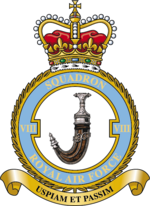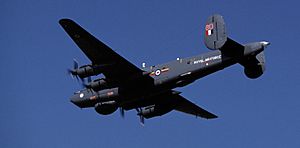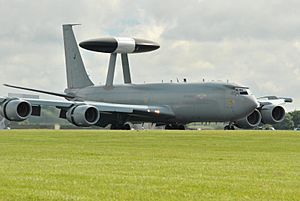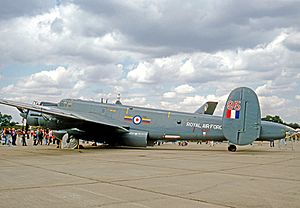No. 8 Squadron RAF facts for kids
Quick facts for kids No. 8 Squadron RAF |
|
|---|---|

Squadron badge
|
|
| Active | 1 January 1915 – 1 April 1918 (RFC) 1 April 1918 – 20 January 1920 (RAF) 18 October 1920 – 1 May 1945 15 May 1945 – 15 November 1945 1 September 1946 – 21 December 1971 1 January 1972 – present |
| Country | |
| Branch | |
| Type | Flying squadron |
| Role | Airborne early warning and control |
| Part of | No. 1 Group (Air Combat) |
| Home station | RAF Lossiemouth (after reforming 2024) |
| Motto(s) | Uspiam et passim (Latin for 'Everywhere unbounded') |
| Mascot(s) | Augustus (A European Eagle Owl) |
| Aircraft | E-7 Wedgetail (entering service from 2024) |
| Battle honours |
|
| Insignia | |
| Squadron badge heraldry | A sheathed Arabian dagger known as a jambiya, adopted in recognition of the unit's long association with Arabia. The weapon is sheathed to symbolise the squadron's guardian duties. Approved by King George VI in December 1943. |
| Squadron roundel |  |
No. 8 Squadron is a special part of the Royal Air Force (RAF). They used to fly big planes called E-3D Sentry AEW1s. These planes were like flying control towers, helping to spot things in the sky. They were based at RAF Waddington in Lincolnshire. In 2021, the RAF decided to stop using these Sentry planes. The squadron's last Sentry flight was in August 2021.
But don't worry, No. 8 Squadron will get new planes! From 2024, they will be the first to fly the Boeing E-7 Wedgetail AEW1. This new plane will take over the job of the Sentry. The squadron will move to RAF Lossiemouth in Scotland.
Contents
History
First World War
No. 8 Squadron started on 1 January 1915 at Brooklands, Surrey. Back then, it was part of the Royal Flying Corps (RFC). Their first planes were the Royal Aircraft Factory B.E.2c. They moved to France in April 1915.
The squadron first flew missions for bombing and scouting far behind enemy lines. In February 1916, they started working closely with the army. They helped by spotting where artillery shells landed and finding enemy positions. They supported big battles like the Battle of the Somme in 1916 and the Battle of Arras in 1917. Their B.E.2 planes were getting old, so they got new Armstrong Whitworth FK.8 planes in August 1917.
By June 1918, No. 8 Squadron was part of the new Royal Air Force. They worked with the Tank Corps during the Battle of Amiens. They became very good at finding and destroying German anti-tank guns. Some of their planes and tanks could even send messages using radio.
A brave pilot named Captain Ferdinand West from 8 Squadron won the Victoria Cross in August 1918. He was flying a plane when seven German fighters attacked him. Even though he was badly hurt, he helped his observer fight off the enemy. He then landed his plane safely and made sure to report what he had seen.
After the First World War ended, the squadron got new Bristol F.2 Fighter planes. They served for a short time in Germany before returning to the UK. The squadron was then disbanded on 20 January 1920.
Reformation
No. 8 Squadron started up again on 18 October 1920 in Helwan, Egypt. They were a day-bomber squadron flying Airco DH.9A planes. In February 1921, they moved to Basra, Iraq. Their job was to help keep peace in Iraq, as the RAF was in charge of security there.
They helped stop a Kurdish rebellion and Turkish attacks in 1922. They also helped people leave the city of Sulaymaniyah. In 1923, they worked against groups in the Mesopotamian Marshes.
In February 1927, the squadron moved to RAF Khormaksar in Aden because of trouble there. They kept their role of keeping peace. They got new Fairey IIIF light bombers in January 1928. They flew missions against different tribes who were causing problems. Sometimes, they would drop bombs on villages after warning people to leave, or destroy crops. This pressure helped bring peace. The squadron also did peaceful jobs like mapping, helping injured people, and carrying mail.
In April 1935, they got Vickers Vincent planes, which were based on a torpedo bomber. In April 1939, they started getting Bristol Blenheim bombers. But they kept some Vincents for flying over the rough areas of the Aden Protectorate.
Second World War
When Italy joined the war against Britain and France on 10 June 1940, No. 8 Squadron quickly went into action. On 12 June, their Blenheim planes bombed an airfield in Eritrea. Their Vincents attacked the same airfield that night.
In August 1940, Italy invaded British Somaliland. No. 8 Squadron's Blenheims flew missions against the Italian troops. The Italians had many more soldiers, and they took the port of Berbera.
The squadron's special badge, an Arabian dagger called a Khunjah, shows their long history in the Middle East. They stayed at RAF Khormaksar in Aden. From December 1943 to May 1945, they flew Vickers Wellington XIIIs.
Post-War (1945–1971)
On 15 May 1945, No. 8 Squadron was reformed in India, flying Consolidated Liberator VIs. But they were disbanded again on 15 November 1945.
The squadron reformed once more at Khormaksar on 1 September 1946. They became a fighter bomber squadron, first with Mosquito FB.6 planes. They later flew Hawker Tempest and Bristol Brigand aircraft. In 1953, they got their first jet planes, the De Havilland Vampire FB.9. They kept updating their jets, flying De Havilland Venom FB.1 and FB.4, and then the Hawker Hunter from 1960 to 1967. The squadron was disbanded again on 21 December 1971.
Shackletons and Sentries (1972–2021)

No. 8 Squadron reformed on 1 January 1972 at RAF Kinloss. Their new job was Airborne Early Warning (AEW), using Avro Shackleton AEW.2s. These planes helped detect other aircraft. They moved to RAF Lossiemouth in 1973.
In 1991, they moved to RAF Waddington and got new planes: the Boeing E-3 Sentry. The first Sentry was given to the RAF on 26 March 1991. The squadron flew missions over the Balkans in the early 1990s. They also saw action over Iraq in 2009 and Afghanistan in 2010. In 2011, they were involved in Operation Ellamy during the Libyan Civil War.
In 2015, No. 8 Squadron sent two Sentries to RAF Akrotiri in Cyprus. They helped with Operation Shader. The E-3D Sentry planes officially retired from the RAF on 28 September 2021.
Future
It was announced in July 2019 that No. 8 Squadron will be the first to fly the Boeing E-7 Wedgetail. This new plane will replace the RAF's E-3D Sentry fleet. The squadron will start using these planes from 2024.
Aircraft operated

Here are some of the aircraft No. 8 Squadron has flown:
- Royal Aircraft Factory BE.2 (1915–1917)
- Armstrong Whitworth F.K.8 (1917–1918)
- Bristol Fighter (1918–1920)
- Airco DH.9A (1920–1927)
- Fairey IIIF (1927–1935)
- Vickers Vincent (1935–1942)
- Bristol Blenheim (1939–1943)
- Lockheed Hudson (1943)
- Vickers Wellington (1944–1945)
- Consolidated Liberator (1945)
- de Havilland Mosquito (1946–1961)
- Hawker Tempest (1947–1949)
- Bristol Brigand (1949–1952)
- de Havilland Vampire FB.9 (1952–1955)
- de Havilland Venom FB.1/FB.4 (1955–1960)
- Gloster Meteor FR.9 (1958–1961)
- Hawker Hunter (1960–1971)
- Avro Shackleton AEW.2 (1973–1991)
- Boeing E-3D Sentry AEW1 (1991–2021)
Magic Roundabout and the RAF

The Avro Shackleton planes used by 8 Squadron for early warning were named after characters from the TV shows The Magic Roundabout and The Herbs. Here are some of their names:
- WL741: PC Knapweed
- WL745: Sage
- WL754: Paul
- WL756: Mr Rusty
- WL757: Brian
- WL790: Mr McHenry (later called Zebedee)
- WL793: Ermintrude
- WL795: Rosalie
- WR960: Dougal
- WR963: Parsley (later Ermintrude II)
- WR965: Dill (sometimes called Dylan) – sadly, this plane crashed on the Isle of Harris on 30 April 1990, and all ten people on board died.
See also
- List of Royal Air Force aircraft squadrons

